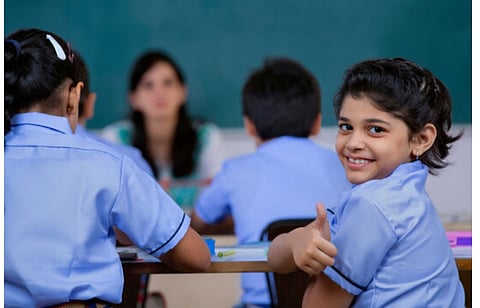
New Delhi- In a recent assessment of the Indian education system by the Union Education Ministry, Punjab and Chandigarh have taken the lead as the best-performing regions in school education for the academic year 2021-22. The rankings, based on the Performance Grading Index (PGI) 2.0, have seen a shift in the positions of traditionally high-performing states.
Kerala, renowned for its achievements in literacy and higher education, has slipped from its top position and now shares the second position with Maharashtra. Last year, Kerala had shared the top honors with Maharashtra and Punjab, with an overall score of 928 out of 1,000. The three poorest performing states/UTs for 2021-22 are Arunachal Pradesh, Meghalaya and Mizoram.
Unfortunately, None of the States/UTs has attained the highest Grade i.e., Daksh. The top-most grade attained in PGI 2.0 is Prachesta - 2, i.e., score range 641-700 indicating that a good proportion of score of the redundant indicators was contained in the total scores of States/UTs in the previous years.
Only 2 States and UTs, namely Punjab and Chandigarh have attained Grade Prachesta -2 (score 641-700) in PGI 2.0. 6 States/UTs joined Grade Prachesta - 3 (score 581-640), 13 States/UTs joined grade Akanshi -1 (score 521-580), 12 States/UTs in grade Akanshi - 2 (score 461-520) and 3 States in grade Akanshi – 3 in PGI 2.0.
The Indian education system, one of the largest in the world, comprises approximately 14.9 lakh schools, 95 lakh teachers, and nearly 26.5 crore students from diverse socio-economic backgrounds. To assess the performance of the school education system at the state and union territory (UT) level, the Department of School Education & Literacy, Ministry of Education, developed the Performance Grading Index (PGI). The PGI for states/UTs was first released for the year 2017-18 and so far, it has been released up to the year 2020-21
The PGI evaluates the education system by analyzing a comprehensive set of indicators. However, over time, certain indicators became outdated, and the structure of the PGI focused more on governance processes rather than quality indicators. To address these shortcomings, align with the new National Education Policy (NEP) 2020, and monitor indicators related to Sustainable Development Goal 4, a revised version of the PGI called PGI 2.0 was introduced for the year 2021-22.
PGI 2.0 comprises 73 indicators grouped into two categories: Outcomes and Governance Management. These categories are further divided into six domains: Learning Outcomes, Access, Infrastructure & Facilities, Equity, Governance Process, and Teacher Education and Training. The new structure emphasizes qualitative assessments, includes digital initiatives, and pays attention to teacher education.
The grading system of PGI 2.0 classifies states and UTs into ten grades, with the highest achievable grade being Daksh, awarded to a state or UT scoring more than 940 points out of 1000. The lowest grade is Akanshi-3, given to regions scoring up to 460 points. The objective of PGI 2.0 is to encourage states and UTs to implement comprehensive interventions that enhance education outcomes across all dimensions.
" The PGI 2.0 scores and grades achieved by states and UTs in 2021-22 highlight the effectiveness of the assessment system. This new edition of the PGI aligns with the policy initiatives and interventions introduced after the implementation of NEP 2020, allowing for better tracking of progress. It enables states and UTs to identify areas of improvement and prioritize interventions to strengthen their school education systems" Dr. Mahesh Sharma, a retired government college professor in Udaipur told The Mooknayak.
The maximum and minimum scores obtained by the States/UTs in 2021-22 are 659.01 and 420.64 respectively. The deviation between the maximum and minimum scores obtained by States/UTs is 238.37 or 23.8% of the maximum points, indicating that, States Arunachal Pradesh, Meghalaya and Mizoram has to put more effort to reach the top slot. This disparity was 51 % in 2017-18 indicating that, PGI also helped to bridge the performance gap amongst States/UTs over the years which may be due to efforts of the government such as look East policy. The reduction in InterState differential is also due to close monitoring of schemes through evidence based PGI which might have helped both the performing and aspiring States and UTs to improve their performance.
Highlights of PGI 2.0
Chandigarh and Punjab fall in Prachesta -2, followed by six states and UTs at the level below. Kerala, Maharashtra, Delhi, Puducherry, Gujarat and Tamil Nadu have been placed at the 7th level — Prachesta-3 — with a score between 581-640 points
The two domains - access and equity - are the only ones where any state (Delhi) managed the top grade (Daksh).
31 states fall in the Utkarsh category in equity parameters while 4 including Ladakh, Meghalaya, Mizoram and Andaman & Nicobar Islands have landed in the Ati-Uttam class.
For learning outcomes, one of the key indicators of good performance, the top performers are Punjab, Chandigarh and Rajasthan while no states/ UTs could achieve the top grade for teacher education and training.
Highlighting the inter-state disparity, the maximum and minimum scores obtained by states/ UTs in 2021-22 are 659.01 and 420.64 respectively.
The three poorest performing states/UTs are Arunachal Pradesh, Meghalaya and Mizoram.
In 2019-20, Punjab, Chandigarh, Tamil Nadu, Andaman and Nicobar Islands and Kerala topped the index, while the index during the Covid period (2020-21) recorded Kerala, Maharashtra and Punjab as the best performing states.
Also Read :
You can also join our WhatsApp group to get premium and selected news of The Mooknayak on WhatsApp. Click here to join the WhatsApp group.